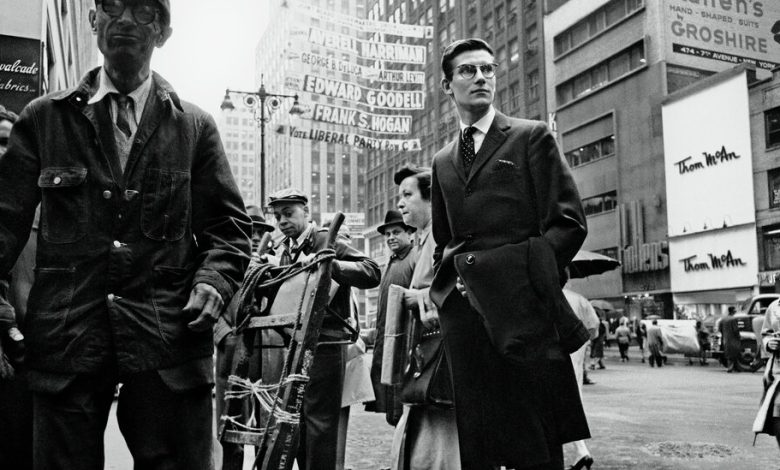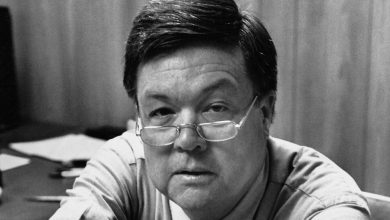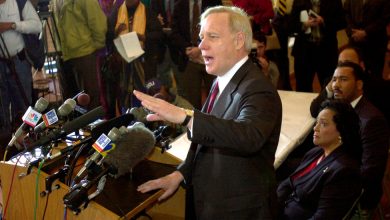Henri Dauman, Photographer of Postwar Celebrity Life, Is Dead at 90

Henri Dauman, a Holocaust survivor and French émigré who as a magazine photographer depicted the ascent of postwar political and celebrity culture with his pictures of President John F. Kennedy’s funeral, Elvis Presley entering and leaving the U.S. Army and Elizabeth Taylor reacting viscerally to a heavyweight title match, died on Sept. 13 at his home in Hampton Bays, N.Y. He was 90.
His death was confirmed by his granddaughter Nicole Jones.
As a freelance photographer, Mr. Dauman was a one-man agency who made his mark in the late 1950s and early ’60s with pictures that had a cinematic look, a quality he attributed to his love of the movies, especially the shadowy world of film noir that he explored as a teenage orphan in postwar Paris.
In 1958, he depicted the designer Yves Saint Laurent in the swirl of Times Square, looking both a part of it and apart from it. The next year he photographed Marilyn Monroe and the playwright Arthur Miller, her husband at the time, during the premiere of the movie “Some Like It Hot.” She looks lovingly at him, but Mr. Dauman said he did not see Miller returning her love.
“I always looked to show the personality of the subjects as they are, not the personality that they project to the public,” he said in “Henri Dauman: Looking Up” (2018), a documentary directed by Peter Kenneth Jones, who is married to Ms. Jones, one of the film’s producers.
In 1960, Mr. Dauman photographed the Floyd Patterson-Ingemar Johansson heavyweight title fight at the Polo Grounds in Manhattan. In “Looking Up,” he recalled taking a few shots of the bout (which Patterson won) but noticed a Hollywood star ringside who was more intriguing: Ms. Taylor, in a sleeveless, low-cut dress, shouting, cringing and cheering.
“That sequence made the story,” he said.
Mr. Dauman followed John F. Kennedy from his campaign for the presidency in 1960 to his inauguration and eventually to his funeral on Nov. 25, 1963. There he captured Jacqueline Kennedy, her face behind a black veil, as she walked in the funeral procession flanked by her husband’s brothers Robert and Edward. His pictures were splashed over five pages of Life magazine.
Mr. Dauman found common ground with Mrs. Kennedy by speaking French to her. Similarly, he chatted with Presley about losing their mothers at a young age. In 1960, he photographed Presley looking forlorn while waving from a train in New Jersey as he headed home to Memphis after his discharge from the Army.
“His pictures were so much alive, even though they were a moment captured from history; each one had a life of its own,” the photojournalist Lawrence Schiller, a friend of Mr. Dauman’s, said in a phone interview. “They opened the door to a different way to think about what you were viewing.”
In addition to Life, Mr. Dauman’s work appeared from the 1950s through the ’70s in The New York Times Magazine and in Newsweek, Smithsonian, New York, Epoca, Der Stern and Paris Match magazines. His work captured civil rights protests, street scenes in New York City and a Bronx gang called the Savage Nomads.
In 1966, he flew to Saigon to find the leader of a group of Buddhist monks who were immolating themselves to protest the Vietnam War. He said in the documentary film that he had “infiltrated” the group and found the leader, Trich Tri Quang. His photograph of him appeared on the cover of the French magazine L’Express with a headline that translated to “The Man Who Makes America Tremble.”
Henri David Dauman was born on April 5, 1933, in Paris. His parents were Jewish immigrants from Poland. His father, Isaja, who was known as Charles, was a milliner. His mother, Chana (Blumenfeld) Dauman, who went by Annette, was a seamstress.
In May 1941, almost a year after France fell to Germany, his father was summoned and arrested by the Vichy regime and later died in the Auschwitz death camp. In July 1942, when the French police tried to break into their apartment, Henri and his mother slipped away to his Aunt Anna’s apartment. They later fled to Paris’s western suburbs. In Limay, Henri was placed in the home of a family acquaintance while his mother found shelter nearby in Mantes-la-Jolie.
Limay and Mantes-la-Jolie became frequent targets of German aerial strafing attacks; at one point a cat Henri was holding was struck, though he was left unharmed. He and his mother soon fled to a farmhouse in Normandy.
After Paris was liberated in 1944, they returned to their apartment, but their time together was brief. His mother died in 1946 after swallowing bicarbonate that had been tainted with poison, one of eight victims of an unscrupulous pharmacist. When his relatives refused to take him in, Henri went to live in the first of two orphanages that became home. As a teenage orphan he had the freedom to work as an apprentice studio photographer, then an assistant fashion photographer and entertainment photographer for Radio Luxembourg and an agency.
In late 1950, at the invitation of an uncle, he emigrated to New York City (though he retained his French citizenship all his life).
In New York he took English lessons, packaged women’s lingerie on an assembly line and worked as an office boy at the Belgian American Chamber of Commerce. In 1954, he began to take pictures of French politicians, artists and movie stars for France-Amérique, a New York City-based newspaper (now a magazine).
Mr. Dauman met his future first wife, Denise Le Goff, at a France-Amérique event. She died in 1985. In addition to his granddaughter Ms. Jones, he is survived by his second wife, Odiana (Somar) Dauman; a daughter and a son from his first marriage, Brigitte Dauman-Suerez and Philippe Dauman, the former president and chief executive of Viacom; a stepson, Denis Somar; five other grandchildren; and two great-grandchildren.
Mr. Dauman’s first assignment for Life was the 1958 marriage of the actress Jean Seberg to François Moreuil in her hometown, Marshalltown, Iowa. His pictures spanned three pages.
In 1964, again for Life, he photographed a Pop Art gallery show in Manhattan, “The American Supermarket,” in which he captured Andy Warhol standing amid shipping cartons that Warhol had painted and a stack of Campbell’s Soup cans, like the 32 he had famously painted two years earlier.
In 1996, Mr. Dauman and Time Inc. sued the Warhol estate in federal court in New York for copyright infringement over Warhol’s use of the Dauman photo of Mrs. Kennedy at her husband’s funeral for silk screen works, including “Sixteen Jackies” (1964).
Mr. Dauman’s case was settled out of court.
When Vanity Fair celebrated his work in 2014, Mr. Dauman was asked to comment on some of his photos, including his 1970 portrait of the director Federico Fellini, who appears perplexed, his fingers splayed over his forehead.
“I wanted him to move in a certain direction,” Mr. Dauman said, “so with my index finger, I put it against his nose and I moved him a little bit. And that’s his reaction!”




